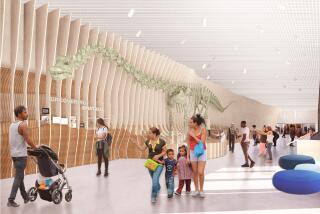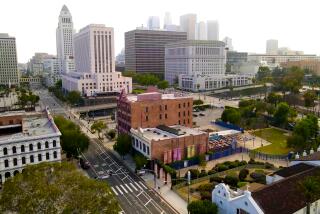Missing Skull From Cathedral Site Is Found in Museum’s Collection
The case of downtown’s missing skull was solved Tuesday when the Natural History Museum of Los Angeles County announced that its collection has long included the cranium--and several other bones--found 40 years ago at what is now the proposed site of a Roman Catholic cathedral.
Native American leaders said that the solution of the mystery reinforces their belief that the property at Temple and Hill streets in downtown Los Angeles might contain an ancient cemetery of their ancestors. If that turns out to be true, cathedral construction plans could be slowed or revised but would not be canceled, according to city officials.
Archeologists working on the $50-million church project had previously reported that only a skull of what appeared to be a prehistoric California Indian was discovered during 1957 construction work on the site. In a recent city environmental impact report for the cathedral project, the archeologists described the skull as missing despite attempts to find it at local museums and the coroner’s office.
“My purpose here is to inform you that the human remains recovered from the site at Temple and Hill streets on Feb. 22, 1957, have resided at our museum for decades; they have never been lost,” Robert J. Lavenberg, the museum’s deputy director of research and collection, said in a letter Tuesday to Cardinal Roger M. Mahony. Lavenberg said his staff had quickly located the bones after reading an article in The Times on Sunday that described how church officials, archeologists and Native Americans all said they hoped to find the missing skull to determine the history of the cathedral site.
The museum said Tuesday that it had not determined the race, gender or age of the remains and had no information on whether they came from a graveyard. The museum invited researchers and Native American leaders to examine them.
Under federal law, Native Americans can claim ancestors’ remains from museums and construction sites, authorize or refuse scientific testing of the bones and rebury them.
While hoping that the project is not slowed down, church leaders pledged to conduct careful excavations and to treat any human remains found on the land with respect. The Community Redevelopment Agency, in response to protests, recently required such exploration plus monitoring by Native Americans.
“All along, the archdiocese has maintained sensitivity to the legacy of the Native American people and this continued sensitivity will ensure ongoing research of the archeological find,” archdiocese spokesman Father Gregory Coiro told a news conference Tuesday at the property, now a hillside parking lot next to the Hollywood Freeway. Construction is scheduled to begin on the cathedral in March 1998, and the cardinal wants to dedicate it in September 2000.
In addition to the cranium, the museum’s related holdings reportedly include a jawbone and teeth and three arm bones. They were clearly labeled as coming from the Temple and Hill property in 1957 and were carefully stored at the museum’s Exposition Park headquarters, museum spokeswoman Gina Ward said.
The recent environmental report suggested that the skull may have been moved to the tract in the early 1950s in landfill from elsewhere that was used to close an old trolley tunnel.
Vera Rocha, a chief of the Gabrielino Shoshone tribal council, attended the archdiocese’s news conference Tuesday and said she was not surprised by the museum’s announcement. “Something was bound to come out. The truth comes out,” she said.
She contended that the ground remains sacred even if the trolley tunnel and other diggings removed any graves in the past. The spirits of the dead remain in the land, she said, and should not be disturbed.
Museum officials insist that they were never contacted in the past by archeologists for the archdiocese about the search for the skull and stressed that they resented any implication that the museum might have been derelict in its duties.
However, Brian Dillon, the archeologist who was hired by the archdiocese to help prepare the environmental impact report, maintained that he had talked in August to someone at the museum by telephone about the skull and was referred to its anthropology curator emeritus Charles Rozaire.
Rozaire was a coroner’s consultant in 1957 and identified the skull then when it was found in a trench being dug for air-conditioning ducts. Rozaire told The Times last week that the patterns of the remaining teeth were those of a California Indian who lived before the Spanish conquest, possibly more than a thousand years ago. He recalled that he left the skull with the coroner and that he saw no other bones in the ditch.
More to Read
Sign up for Essential California
The most important California stories and recommendations in your inbox every morning.
You may occasionally receive promotional content from the Los Angeles Times.











